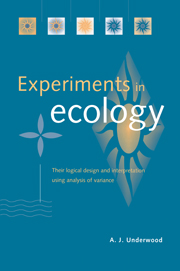Book contents
- Frontmatter
- Contents
- Acknowledgements
- 1 Introduction
- 2 A framework for investigating biological patterns and processes
- 3 Populations, frequency distributions and samples
- 4 Statistical tests of null hypotheses
- 5 Statistical tests on samples
- 6 Simple experiments comparing the means of two populations
- 7 Analysis of variance
- 8 More analysis of variance
- 9 Nested analyses of variance
- 10 Factorial experiments
- 11 Construction of any analysis from general principles
- 12 Some common and some particular experimental designs
- 13 Analyses involving relationships among variables
- 14 Conclusions: where to from here?
- References
- Author index
- Subject index
8 - More analysis of variance
Published online by Cambridge University Press: 05 June 2012
- Frontmatter
- Contents
- Acknowledgements
- 1 Introduction
- 2 A framework for investigating biological patterns and processes
- 3 Populations, frequency distributions and samples
- 4 Statistical tests of null hypotheses
- 5 Statistical tests on samples
- 6 Simple experiments comparing the means of two populations
- 7 Analysis of variance
- 8 More analysis of variance
- 9 Nested analyses of variance
- 10 Factorial experiments
- 11 Construction of any analysis from general principles
- 12 Some common and some particular experimental designs
- 13 Analyses involving relationships among variables
- 14 Conclusions: where to from here?
- References
- Author index
- Subject index
Summary
Having waded through a detailed introduction to analyses of variance, there are other crucial issues to sort out. These are the definitions of two types of experimental treatments, the power of an analysis of either kind and how to determine the alternative to the null hypothesis if the analysis of variance causes you to reject it.
Fixed or random factors
One very important consideration in an analysis of variance is to be sure whether experimental treatments represent fixed or random factors. This makes little practical difference for a one-factor analysis, but will turn out to matter a great deal for extensions beyond one factor. The distinction was made explicit by Eisenhart (1947) in his thoughtful consideration of different models in experimental designs.
There are many ways of considering this issue but, in the end, they all boil down to you, the experimenter, also being very thoughtful about your hypotheses. The relevant definition of an experimental factor is a function of the way hypotheses are stated and not a property of the analysis. As an immediate consequence of this, you should always know which sort of factor you have, because you cannot interpret the experiment without the hypothesis being clear. As will be demonstrated below, the statement of an hypothesis requires definition of whether or not the experimental treatments are fixed or random.
The difference revolves around whether you are concerned with specific, identifiable required treatments (which would make a fixed factor) or whether you are interested in a general problem, some components of which are included (representatively) in the experiment.
Information
- Type
- Chapter
- Information
- Experiments in EcologyTheir Logical Design and Interpretation Using Analysis of Variance, pp. 198 - 242Publisher: Cambridge University PressPrint publication year: 1996
Accessibility standard: Unknown
Why this information is here
This section outlines the accessibility features of this content - including support for screen readers, full keyboard navigation and high-contrast display options. This may not be relevant for you.Accessibility Information
- 1
- Cited by
